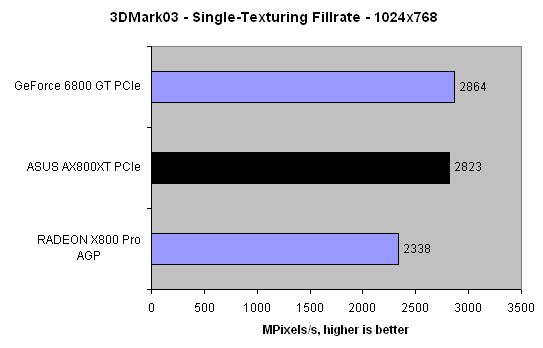Fillrate and shading
I'll take a brief look at basic specifications and fillrate/shading power of the three cards.| Card | ASUS AX800XT PCIe | RADEON X800 Pro AGP | GeForce 6800 GT |
| Interface | PCI Express (X16) | 8x AGP | PCI Express (X16) |
| Render setup | 16x1 | 12x1 | 16x1 |
| Onboard memory | 256MB GDDR3 | 256MB GDDR3 | 256MB GDDR3 |
| Core speed | 500MHz | 475MHz | 350MHz |
| Multi-texture fillrate | 8000MTexel/s | 5700MTexel/s | 5600MTexel/s |
| Memory speed | 1000MHz | 900MHz | 1000MHz |
| Memory bus width | 256-bit | 256-bit | 256-bit |
| Memory bandwidth | 32GB/s | 28.8GB/s | 32GB/s |
Compared to, say, an AGP-equipped X800 Pro, the ASUS AX800XT PCIe card has advantages in both pixel-pushing and bandwidth counts. It should do, too, as it's a card that will probably be priced at around £50-£60 more. Apart from the interface, a PCIe X800 XT's specs mirror that of its AGP counterpart. However, AGP cards are also sold as Platinum Editions, ones characterised by a 20MHz core speed and 120MHz memory speed advantage.

Using 3DMark03's single-texturing fillrate as a basis for judging efficiency when a sole texture is applied, the ASUS AX800XT is just a touch behind NVIDIA's GeForce 6800 GT PCIe card. That's a little surprising given the XT's 150MHz core speed advantage. How about when more than one texture is applied to a pixel?.

A near-linear increase from an X800 Pro, given that an X800 XT has 33% more rendering grunt than a Pro (16 vs 12 pipes). A GeForce 6800 GT PCIe card is firmly put into the shade.

Vertex shading also shows only a slight increase from a Pro model, and about 20% above a GT's.

Pixel Shader 2.0, though, is far better the PCI-Express X800 XT.









